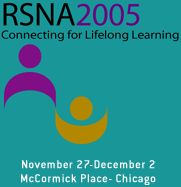
Abstract Archives of the RSNA, 2005
Amarinthia Elliott Curtis, Presenter: Nothing to Disclose
Bin Sing Teh MD, Abstract Co-Author: Nothing to Disclose
Arnold C. Dela Paulino MD, Abstract Co-Author: Nothing to Disclose
Kam Chiu, Abstract Co-Author: Nothing to Disclose
Brian Butler, Abstract Co-Author: Nothing to Disclose
Purpose/Objective: Co-morbid conditions have importance to patients and their physicians for several reasons. Co-morbidities may affect quality of life, treatment planning, toxicities, and outcome. Hypertension, diabetes, and obesity are risk factors for cancer deaths as well as death from other causes. As oncologists strive to return patients to health and well being, learning of the co-morbid disease burden in our patient population can help us counsel patients and arrange for appropriate care before, during and after radiation treatment. Materials/Methods: One hundred consecutive adult patients seen for initial consultation in November and December 2004 were evaluated for the presence of diabetes, hypertension, elevated blood pressure, and obesity. Diabetes was defined as a person who admitted to diabetes when asked or who was taking a diabetic medication. Hypertension was defined as a patient who admitted to hypertension when asked at initial evaluation. Elevated blood pressure was defined as having a systolic blood pressure >140 or diastolic blood pressure >90 at initial consultation. Obesity was defined as having a body-mass index (BMI) >30 and overweight as a BMI of 25-30. The prevalence of these diseases was compared with the prevalence in the United States adult general population. Results: One hundred patients ages 18-83 (mean 57.1) with 48% male were evaluated. Fourteen patients did not have their height recorded and therefore were not assessable for BMI and were excluded from the analysis of overweight and obese patients. Hypertension, diabetes and blood pressure were recorded for all patients. Thirty-three per cent of patients had a history of hypertension. Twenty-seven patients had an elevated single blood pressure at initial consultation. Eleven percent of patients had diabetes. Obesity was present in 33% of evaluable patients and a designation of overweight was present in an additional 34% for a total of patients with BMI >25 of 68%. Of patients treated for curative intent (59 patients), 71% had a BMI >25 and 38.5% had a BMI>30. According to the CDC the prevalence of diabetes in adults in 2002 was 8.7%, hypertension 28% and obesity 31%. Conclusions: Concurrent with patterns in the United States, patients in a radiation oncology clinic had a high burden of hypertension, diabetes and obesity. The rates for diabetes and hypertension were similar to the general population. The rate of obesity in patients being treated for curative intent was large (38.5%) as compared to the rate in the general population (31%). This may be related to sample size or may be related to a higher rate of obesity related cancers. The radiation oncology patient population has a burden of co-morbid diseases equal to or greater than that of the general population. Consideration for these co-morbidities and their impact on quality of life, treatment planning, side ffects and outcome should have a place in counseling patients and in providing for appropriate care.
Curtis, A,
Teh, B,
Paulino, A,
Chiu, K,
Butler, B,
Prevalence of Co-Morbid Diseases in a Radiation Oncology Population. Radiological Society of North America 2005 Scientific Assembly and Annual Meeting, November 27 - December 2, 2005 ,Chicago IL.
http://archive.rsna.org/2005/4420786.html

